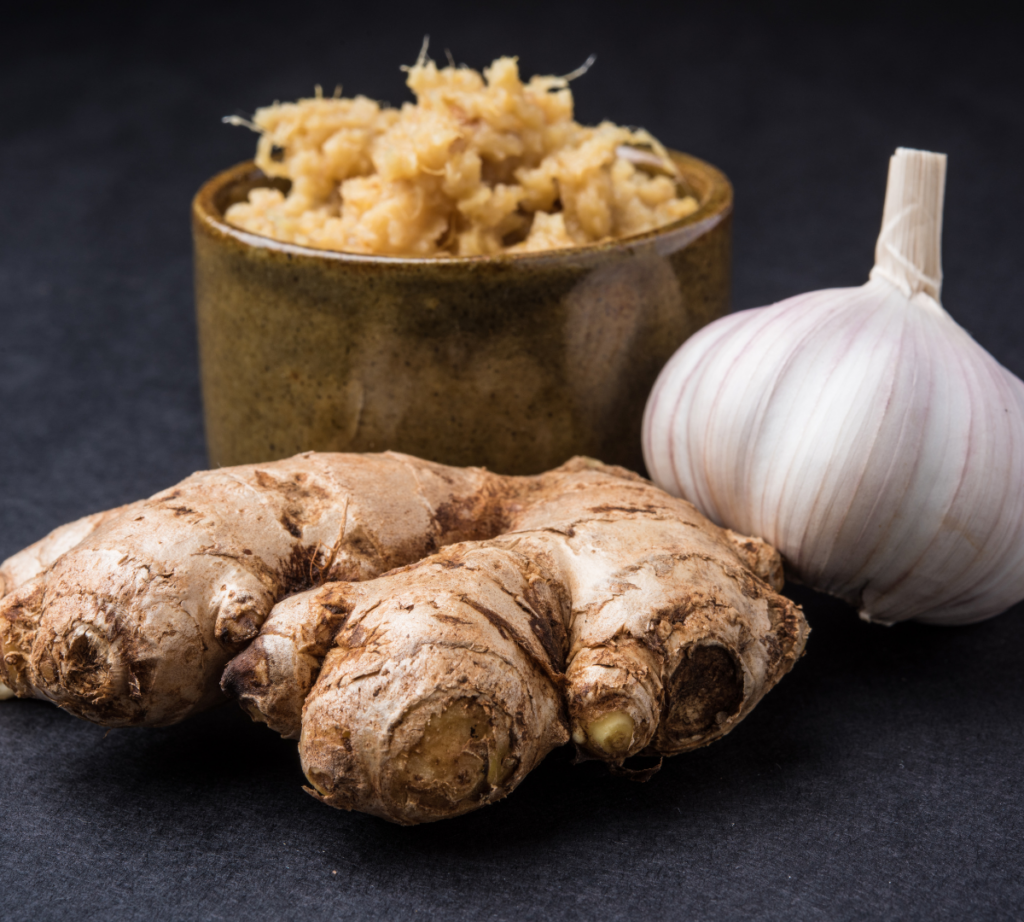Garlic and Ginger Together: Like two peas in a pod -Treating Inflammation with Garlic, Ginger, and Food
May 3, 2024
Garlic and ginger are culinary staples renowned not only for their flavor-enhancing properties but also for their profound health benefits. Decades of scientific inquiry have illuminated their potent anti-inflammatory and antioxidant prowess, suggesting a potential shield against various diseases.
One of the most celebrated attributes of garlic and ginger is their shared capacity to mitigate inflammation. Research indicates that combining these two potent ingredients yields synergistic health advantages. Whether integrated into savory stir-fries or hearty soups or consumed as supplements, their amalgamation showcases remarkable anti-inflammatory and antioxidant capabilities, potentially curtailing the activity of pro-inflammatory proteins implicated in inflammatory responses.

Inflammation, a cornerstone of the immune system’s defense mechanism, is a biological riposte against assailants such as infections, injuries, and toxins, facilitating the body’s self-repair. However, when inflammation persists unchecked, it transforms into chronic inflammation, perpetually placing the body on high alert and potentially wreaking havoc on tissues and organs. The ramifications of chronic inflammation are manifold, potentially spanning from cancer to stroke.
The symptoms of chronic inflammation, ranging from mild to severe, encompass fatigue, bodily discomfort, mood disturbances like depression and anxiety, and gastrointestinal perturbations such as diarrhea or constipation, alongside fluctuating weight and susceptibility to infections. Triggered by various factors, including pathogens, cellular damage, and environmental toxins, chronic inflammation can instigate detrimental inflammatory cascades across various bodily systems, culminating in tissue damage or disease.
The etiology of chronic inflammation is multifaceted. While lifestyle factors like smoking, chronic alcohol consumption, and prolonged stress are acknowledged contributors, other instigators include untreated acute inflammatory conditions, autoimmune disorders, and sustained exposure to irritants such as industrial pollutants or toxic fumes.
Enter the anti-inflammatory diet, a nutritional regimen lauded for its potential to assuage systemic inflammation. Drawing inspiration from dietary paradigms like the Mediterranean diet, this approach emphasizes consuming whole, unprocessed foods abundant in anti-inflammatory agents like leafy greens, nuts, and fruits. By eschewing processed fare laden with sugars, unhealthy fats, and chemical additives, adherents may cultivate an internal environment conducive to quelling inflammation.
Essential dietary modifications include eliminating processed foods such as commercially baked confections, snacks like chips and popcorn, and preservative-laden meats and cheeses. In their stead, emphasis is placed on whole, single-ingredient foods sourced from nature’s bounty, encompassing grains like brown or wild rice, lean proteins like poultry and fish rich in omega-3 fatty acids, legumes, nuts, seeds, and wholesome staples like oats and eggs.
Studies extol the virtues of anti-inflammatory dietary frameworks such as the Mediterranean and DASH diets, which have demonstrated efficacy in ameliorating inflammation, cholesterol levels, blood pressure, and weight management. While the Mediterranean diet champions the consumption of omega-3-rich fish and eschews processed oils, the DASH diet focuses on hypertension management through protein and sodium moderation, with slightly different dietary emphases.
For individuals grappling with food intolerances or inflammatory conditions, the effects of dietary modifications may manifest within weeks, underscoring the significance of personalized nutritional strategies. However, achieving sustainable results necessitates a commitment to long-term dietary adherence, with noticeable improvements typically emerging within three to six months.
In navigating the complex interplay between diet, inflammation, and health outcomes, a holistic approach integrating dietary modifications with lifestyle interventions holds promise in fostering enduring well-being and vitality.
This presentation is drawn from my forthcoming book:
4 Chronic Disorders, Diseases, and Syndromes Demystified: A Proven Five-Step, Understand and Implement Self-Healing Guide to Prevent, Treat, and Possibly Reverse Digestive Tract Conditions, Including Gut, Inflammatory, and Autoimmune Disorders, Diseases, and Chronic Pain Syndrome, by Making Simple Lifestyle Changes
Click on the Following CLICKABLE LINKS to:
- Read About the Book.
- Please sign up for the release date, book formats, and availability.
- Would You Like to Receive Weekly Newsletter?
- Privacy Pledge: We will ‘NEVER’ sell your contact or Personal Information under any circumstances. EVER!
Sources:
7 Impressive Benefits of Combining Garlic and Ginger. Healthline Nutrition. https://www.healthline.com/nutrition/garlic-and-ginger-benefits?slot_pos=article_1&utm_source=Sailthru%20Email&utm_medium=Email&utm_campaign=authoritynutrition&utm_term=A&utm_content=2021-05-12&apid=26018562&rvid=c5a2cbdf6c99dc0166ae317f357d9700f523cce0bff4d7b3cda7e6793974bb89
Anti-Inflammatory Diet Do’s and Don’ts. Arthritis Foundation. https://www.arthritis.org/health-wellness/healthy-living/nutrition/anti-inflammatory/anti-inflammatory-diet
Chen L, Deng H, Cui H, Fang J, Zuo Z, Deng J, Li Y, Wang X, Zhao L. Inflammatory responses and inflammation-associated diseases in organs. Oncotarget. 2017 Dec 14;9(6):7204-7218. doi: 10.18632/oncotarget.23208. PMID: 29467962; PMCID: PMC5805548.
Chronic Inflammation. Pahwa R, Goyal A, Jialal I. Chronic Inflammation. [Updated 2023 Aug 7]. In: StatPearls [Internet]. Treasure Island (FL): StatPearls Publishing; 2024 Jan-. Available from: https://www.ncbi.nlm.nih.gov/books/NBK493173/
Why and How to Start an Anti-Inflammatory Diet. Nutrition (2022). Cleveland Clinic: Health Essentials. https://health.clevelandclinic.org/anti-inflammatory-diet
Disclaimer: Please note that the information contained within this document is provided solely for educational and entertainment purposes. Every effort has been made to ensure the presentation of accurate, up-to-date, reliable, and complete information. However, no warranties, whether expressed or implied, are declared or implied. Readers acknowledge that the author does not provide legal, financial, medical, or professional advice. The content within this book has been compiled from various sources. It is highly recommended to consult a licensed professional before attempting any techniques outlined in this book.